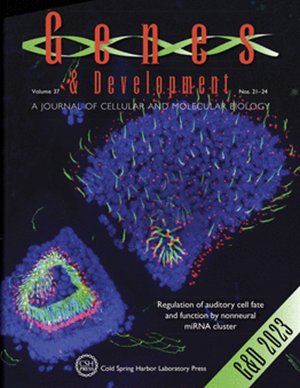A genome-wide, CRISPR-based screen reveals new requirements for translation initiation and ubiquitination in driving adipogenic fate change
IF 7.7
1区 生物学
Q1 CELL BIOLOGY
引用次数: 0
Abstract
In response to excess nutrients, white adipose tissue expands by both generating new adipocytes and upregulating lipogenesis in existing adipocytes. Here, we performed a genome-wide functional CRISPR screen to identify regulators of adipogenesis in the mouse 3T3-L1 preadipocyte model. In this pooled screening strategy, we used FACS to isolate populations based on lipid content, gating for fluorescence intensity of lipophilic fluorescent BODIPY dye. Additionally, we categorized whether the gene functions primarily during mitotic clonal expansion, lipogenesis, or both. We found that translation initiation and ubiquitin-dependent protein stability regulators drive both adipogenic fate change and lipogenesis. We further supported these findings with proteomics, demonstrating that essential changes in protein reprogramming can drive or inhibit 3T3-L1 adipogenesis independent of transcription. Furthermore, we demonstrated that specific branches of the hypusination pathway, a conserved regulator of translation initiation, are critical for translating adipogenic inducers of mitotic clonal expansion and that the neddylation/ubiquitin pathway modulates insulin sensitivity during lipogenesis.基于crispr的全基因组筛选揭示了翻译起始和泛素化在驱动脂肪生成命运变化中的新要求
作为对过量营养的反应,白色脂肪组织通过产生新的脂肪细胞和上调现有脂肪细胞的脂肪生成来扩张。在这里,我们进行了全基因组功能CRISPR筛选,以鉴定小鼠3T3-L1前脂肪细胞模型中脂肪形成的调节因子。在这种混合筛选策略中,我们使用FACS根据脂质含量分离群体,对亲脂性荧光BODIPY染料的荧光强度进行筛选。此外,我们分类了该基因是否主要在有丝分裂克隆扩增、脂肪生成或两者中起作用。我们发现翻译起始和泛素依赖的蛋白质稳定性调节因子驱动脂肪生成命运的改变和脂肪生成。我们用蛋白质组学进一步支持了这些发现,证明蛋白质重编程的基本变化可以独立于转录驱动或抑制3T3-L1脂肪形成。此外,我们证明了翻译起始的保守调节因子hypusination通路的特定分支对于翻译有丝分裂克隆扩增的脂肪生成诱导剂至关重要,并且类化修饰/泛素通路调节脂肪生成过程中的胰岛素敏感性。
本文章由计算机程序翻译,如有差异,请以英文原文为准。
求助全文
约1分钟内获得全文
求助全文
来源期刊

Genes & development
生物-发育生物学
CiteScore
17.50
自引率
1.90%
发文量
71
审稿时长
3-6 weeks
期刊介绍:
Genes & Development is a research journal published in association with The Genetics Society. It publishes high-quality research papers in the areas of molecular biology, molecular genetics, and related fields. The journal features various research formats including Research papers, short Research Communications, and Resource/Methodology papers.
Genes & Development has gained recognition and is considered as one of the Top Five Research Journals in the field of Molecular Biology and Genetics. It has an impressive Impact Factor of 12.89. The journal is ranked #2 among Developmental Biology research journals, #5 in Genetics and Heredity, and is among the Top 20 in Cell Biology (according to ISI Journal Citation Reports®, 2021).
 求助内容:
求助内容: 应助结果提醒方式:
应助结果提醒方式:


